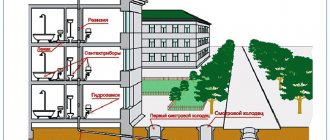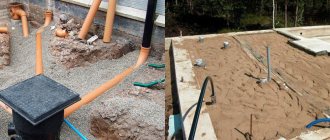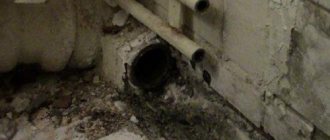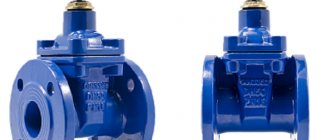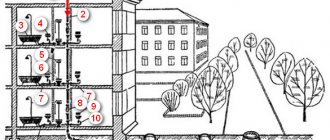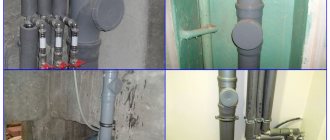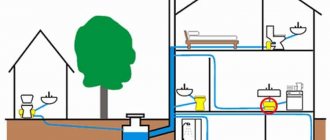Situations when residents of apartment buildings for some reason cannot pay their utility bills are becoming more and more common; in order to encourage them to solve this problem, state housing maintenance services or private management companies are resorting to various methods. One of the latest methods of influence is a sewer plug for debtors, which causes ambiguous opinion in society regarding the legality of its installation.
Since sewer plugs are often placed on citizens based on a bureaucratic approach to their difficult life situations, the network offers a number of ways to independently dismantle or destroy these devices. There are also legal options for solving problems with plugs, and there are precedents when the court decided such cases in favor of the tenant, obliging the management company to pay him compensation.
Rice. 1 Intra-house sewerage diagram
What is a sewer plug for debtors?
According to the government decree of the Russian Federation dated 05/06/2011 354 (last amended on 05/22/2019) on the provision of utility services to users or owners of premises, the management organization (executor) has the right to take measures to suspend or completely disconnect the apartments of defaulters from certain sources of life support. The legislation does not specify specific utilities from which an apartment can be cut off; the ban only applies to turning off heating and cold water. Accordingly, the management organization has the right to stop the supply of electricity, gas, hot water and shut off water drainage.
With the exception of electricity, the distribution panel of which is installed in the common corridor, access to the apartment is required to turn off gas or hot water - this is not always possible if the tenant simply does not open the door. Therefore, the contractors use methods of blocking communications without access to apartments, and the only one of them after a power outage in a common area is installing a plug on the debtors’ sewer system. The plug is installed through the outlet of the sewer riser on the roof without access to the living space; it is lowered on a long cable and automatically closes the sewer outlet from the apartment after the automatic system is triggered.
Rice. 2 Sewer plug for debtors - operating principle and placement for disconnecting the sewerage service
Purpose of the device
The plug is a kind of valve that closes the sewer hole intended to connect the common riser with the system of a separate apartment. This method is used by utility service employees when non-payers do not allow them into the apartment.
The partition is installed on a branch from the common riser.
The device is inserted through a drain pipe that goes into the attic, and a valve is installed. It prevents waste from passing through the drain. Accumulating near the plug, they clog the toilet and pipes that extend from the bathtub and sink.
The rate of clogging is determined by the type of valve. If it is made in the form of a lattice, then water will pass through, and only solid particles will accumulate. When installing a solid plug, the side hole is completely blocked.
This is interesting: Step-by-step instructions for repairing a ball valve: it’s better to see once
Types of plugs
When installing a plug through a riser on the roof, it is important to determine the location of the debtor’s apartment and bring it to the sewer outlet pipe. To do this, the device is lowered on a cable using a special manipulator, using a video review from the camera to monitor the installation process. Upon reaching a given point, the manipulator activates the plug, while it changes its shape and blocks the inlet to the riser, after which the installation apparatus is removed from the riser pipeline to the surface. All plugs for sewer pipes can be divided into two main types: cylindrical and pneumatic.
Cylindrical
A cylindrical type sewer plug consists of one or more metal plates placed vertically in a partial circle. After lowering into the riser, the manipulator moves the fragments apart, or rather releases the plates from compression; they, due to a spring mechanism, expand and tightly cover any side holes in the riser. The device covers the side walls, and not the channel itself, so there are no problems with other residents higher up the riser.
Some semicircular varieties have teeth on the side edges; due to the elasticity of the material when compressed by a manipulator, they initially have a smaller diameter than the internal size of the riser pipeline. After lowering the riser to a given point, the manipulator releases the plug, it straightens and is held in the pipeline by the end gear plates.
In addition to metal, a cylindrical sewer plug is often made of plastic (polypropylene); its transparent modifications, with a rubber surface or an armored anti-vandal design, are usually used.
One of the varieties of plugs of this type is a device with a mesh on a rigid frame (holes in the plate) instead of a solid valve; its installation is no different from other models, but allows the debtor to use cold and hot water.
The pipe plugs supplied to the market and the corresponding installation devices are represented by a wide range of models; their brands with the names Terminator, Cockroach, Octopus, Grotto, Whale, Onyx have different designs.
Rice. 3 Sewer plug for cylindrical type debtors
It should be noted that the installation of any structures in the riser is essentially a violation of the rules of technical operation of sewer systems; foreign objects can lead to clogging of the passage channel (for example, rags or feminine hygiene items will get caught on the sharp edge of the plug).
Pneumatic
A pneumatic type sewer pipe plug is a durable ball made of plastic materials (rubber) with needle-shaped protrusions on the outer shell. It is loaded into the riser using a manipulator and pushed into the side sewer outlet. After placement, the compressor supplies air to the ball, it increases in volume and closes the side pipe.
This design has one main advantage and disadvantage: the ball does not block the passage channel in the riser, but, unlike a cylindrical design, it is much easier for the debtor to damage and dismantle it.
Rice. 4 Sewer plug for debtors, pneumatic
Sewer plugs for debtors - is their installation legal?
To answer the question of whether a management organization is authorized to install a sewer plug for debtors for non-payment, one should consider the fundamental document, which is Government Decree of the Russian Federation No. 354. The main provisions for the actions of public utilities in relation to debtors are indicated in paragraph XI, paragraphs 114 - 119, their contents are as follows:
1. In case of utility debts from residents, the contractor is obliged to seal electrical panels, plumbing fixtures and other equipment both inside and outside the apartment of the debtor consumer.
2. Regardless of the presence or absence of an agreement with the resource supplying organization from whose networks the debtor is cut off, disconnection operations are carried out by an organization engaged in the maintenance of utilities at home.
3. To carry out the work, a court decision is not required; the basis is an application from the organization supplying the resource or providing services.
4. If the rent is not paid in full, the contractor is obliged to knowingly notify the defaulter before limiting or stopping the provision of services. By incomplete payment we mean an amount higher than 2 months’ payment for one utility service.
5. In case of partial payment of rent, the entire amount is divided between services and expenses for technical operation, deductions for major repairs in proportion to their size. It should be noted that this clause excludes the legal loophole that the debtor could take advantage of by paying the minimum amount of rent with a statement that he only pays sewerage services with the expectation that a plug will not be installed.
Rice. 5 Mesh plug for sewerage for debtors
Additional Responsibility
The Government Decree of 2006 (No. 491) provides that the costs incurred by the service organization for debt collection activities are borne by the debtor. In addition, in accordance with current regulations in the field of public utilities, unauthorized intervention in the engineering and technical systems of an apartment building entails the obligation of the culprit to compensate for losses incurred during the restoration of the network.
As for removing the stub yourself, these actions cannot be considered illegal. The fact is that the owner carries out all manipulations from his apartment.
We put a plug on the sewer - what to do?
Consumers who find themselves in a situation with a blocked sewer outlet have several ways to solve the problem; they can be roughly divided into legal and illegal. The measures taken by the consumer debtor consist of the following actions:
- Full payment of the rent debt, in this case the contractor must remove the plug within 2 days.
- Usually, a person who finds himself in a difficult life situation can always come to an agreement with the management organization in the form of a written agreement with the executor on debt restructuring. In this case, an agreement is concluded between the parties with phased monthly payment of the resulting debt, although for the last month the rent will have to be paid in full.
- Since, in the opinion of many human rights activists, this method of dealing with defaulters is a humiliation of human dignity and even equates to torture, if the consumer-debtor has valid reasons for not paying rent on time, you can file a claim with the European Court of Human Rights ECHR after going through all legal proceedings authorities of the Russian Federation.
It is clear that citizens with such capabilities are unlikely to find themselves in the situation of rent debtors, because filing a claim will require the services of expensive lawyers. In addition, the cost of the issue is not too high and the application is likely to be rejected for consideration.
- The reason for appealing to the Russian courts may be a violation of user rights when installing a blind sewer plug. Since, according to the law, the contractor does not have the right to turn off cold water to debtors, and the use of a plug actually leads to its shutoff due to the impossibility of draining, there is some probability of obtaining a decision in the courts to cancel the installation. It is clear that suing the state housing maintenance service from the same branch with the court is problematic, however, if the management company is a private structure, the chances of winning the case increase.
- Another legal clue for appealing to the courts is blocking the sewer system for a defaulter in a communal apartment with several owners who do not have rent arrears. A similar situation is if tenants live in the same apartment with separate settlement accounts for rent and one of the parties has no utility debts.
- You can turn to “black” plumbers who have equipment for installing and removing plugs, but this will require free access to the roof through a closed technical floor, and the cost of the service can be quite significant.
- If a consumer-debtor has been given a plug, he has already received money in the amount of about 10,000 rubles, which will be forcibly deducted from him for installing and dismantling the device. There is no doubt that this amount also includes the price of the plug itself, the cost of which is not too high and it cannot always be reused.
Therefore, the debtor consumer can independently try to remove the plug with virtually no consequences, while at the same time providing a good service to the company - its specialists will not have to go to the site and waste time dismantling it.
Rice. 7 Sewer plug for debtors. installed on the toilet
Operating principle of the drainage blocking system
Which method of exposure to choose, turning off the lights or limiting water disposal, is decided based on specific conditions. Less hassle of cutting the light. When this cannot be done for some reason, the owner will face no less severe measures. This is the installation of a plug in a sewer riser. Why is this method chosen, and not turning off, for example, the same hot water that is permitted by law? The reason is in the design of utility networks. Of course, you can shut off the hot water riser, but this will leave all your neighbors without water. To turn off the water only to the debtor’s apartment, you need to enter his territory. It is easy to imagine what the debtor will answer when a locksmith calls him, offering to let him into the apartment, where he will turn off the hot water. At best, the plumber will have to listen to the owner’s non-literary monologue and instructions on which route to take. Therefore, a method was found to put pressure on non-payers by specifically blocking the sewer system using a plug. In this case, not a single apartment connected to the same riser as the debtor’s apartment will be affected. It is easy to understand how a stub works using the following example. Imagine many small streams running from the mountains and flowing into one river. If you block one stream with a dam, the others won’t care. They will also flow into the river; the dam will not stop them. A plastic plug installed in the sewer system works on the same principle.
Sewer plug design for non-payers
What does a formidable weapon in the fight against a debtor, a sewer plug, look like? Imagine an ordinary pipe with a diameter of 100 mm, about 20-30 cm long, cut in half lengthwise. One half of such a segment is that same stub. Its convex part is attached to the sewer outlet of the debtor's apartment, and the concave plug looks at the common riser, without interfering with the drains from other apartments being freely removed.
What does the sewer plug installation system consist of?
Equipment for blocking sewers for housing and communal services debtors is produced by different factories and manufacturers. This is not a cheap gadget, but management companies spend the money because the result justifies this expensive purchase. The kit for installing the plug includes:
shockproof control panel with monitor, it has a built-in battery, can work from the mains or autonomously;
a waterproof probe with two video cameras built into it, they work in any, even aggressive, environment;
DVR for recording video of installation or dismantling of the plug;
flexible hose for lowering the plug into the sewer system;
control panel and the plug itself.
The entire complex of work must be carried out by two people. It will take no more than 30 minutes to install the plug in one apartment.
Installing a drain plug
Before installing the plug, utility workers check the layout of the risers in the apartment, the number of risers, and the working condition of the sewerage system. If there is a blockage, you will not be able to install the plug. If the risers are in good condition, the debtor is notified that a sanction has been applied to him in the form of blocking the drains, you can proceed directly to the process of introducing a plug. Having climbed to the roof of the house, they determine the location of the drain pipe of the riser of the “bad” apartment. Through it, a plug attached to the probe is lowered to the debtor’s apartment. Its progress is monitored on the monitor. As soon as the plug reaches the sewer outlet from the debtor's apartment, the operator on the roof, using the control panel, disconnects it from the probe and the plug is inserted exactly along the cross-section of the outlet. The sewage drain from the debtor's apartment is blocked. The plug has a special retainer that helps it stay in the pipe opening and block the flow. You can also remove the plug using equipment. It will be difficult for the debtor to remove the interfering device on his own, although there are ways. True, they are labor-intensive. The easiest way to get rid of the stub is to pay off the debt. Within 1-2 days after repayment of the debt, utilities will restore sewerage.
The procedure for installing and removing a sewer plug
Almost all multi-storey buildings have a central riser that runs through all floors and ends in a vent pipe on the roof, which is necessary for ventilation and air access to the duct. Therefore, theoretically and practically, installing a plug through a pipeline from the roof to any apartment does not present any particular difficulties; operations are carried out in the following sequence:
- Using a special camera and lighting, the condition of the sewer riser (the surface of the inner shells of the pipes) in the overlap area is studied, and based on this, the type of plug is determined. At the same time, the material of manufacture of the riser is also taken into account - different types of plugs are installed on smooth polyvinyl chloride (PVC) plastic and cast iron pipes rough on the inside.
- Next, they begin to immerse the plug, models with sharp teeth are lowered into a PVC plastic pipe for fixation on smooth walls, and self-expanding structures are placed in cast iron risers.
- After the user pays the rent in full, representatives of the installation company return to the roof and lower the manipulator into the sewer shaft. An operator-controlled device compresses the sliding structure or releases air from the ball, after which it removes the plug to the surface.
Rice. 8 Cylindrical sewer plug for debtors placed in the sewer tee
How to remove a plug in a sewer and can you do it yourself?
Considering that the consumer-debtor has the right to legally not allow employees of the management organization into his apartment, it is problematic to prove the fact that the plug was removed. The tenant can always claim that he knows nothing about its fate and suggest that it was poorly installed and fell into the riser shaft itself.
There are different methods of how to remove a plug from a sewer yourself, depending on its specific design, the material of manufacture of the riser pipeline, the main ones are:
Universal . Since the damper is located at the outlet of the riser pipe, to which the toilet is connected through a corrugation, the easiest way is to remove the plug from the sewer by dismantling the plumbing fixture. To do this, unscrew the two screws securing the toilet to the floor, close the valve and disconnect the flexible cold water supply from it, after which the device is removed from the toilet room. Next, remove the corrugation and observe the plug itself in the short outlet pipe of the riser.
If a pneumatic model in the form of an inflatable ball is installed, it is pierced with a sharp object and removed by hand. If a cylindrical damper is placed in a riser channel, it is destroyed physically - the metal (polymer) plates are damaged with a steel crowbar or a nail puller, a hole is drilled around the perimeter of the pipe with a long drill using a drill, after which the passage is cleared or the plug falls into the sewer. If there is a mesh, you can cut it with metal scissors or expand the cells with a crowbar for better drainage passage.
Chemical method
The basic principle is to use alkaline components.
You can pour the drug “Mole” into the sewer yourself; it is often used to remove blockages. After reacting with water, the mixture will begin to boil and the sewer plug will gradually dissolve. It must be said that this method can only work if the plug is metal, since the rubber ball does not corrode. In addition, it will take at least a week for “Mole” to dissolve the metal.
Useful tips
If a management organization practices installing sewer plugs in the apartments of debtor users, one of the useful tips is to prevent such a situation. In addition to the significant inconvenience of living without a sewer system, the amount of debt for utilities will increase even more due to the cost of installing a shutter device.
If you choose the lesser of two evils, it is better to allow the contractor’s workers into the apartment and allow them to put a plug on the hot water; without it you can live much more comfortably than without sewerage.
An almost win-win option is to drill a through hole in the riser pipe in advance and screw a bolt or insert a pin into it - then they won’t be able to lower the plug and install it on top, you won’t have to pay money for its installation, and you won’t have to let anyone into the apartment.
The only problem that may arise for residents of the lower floors is the possibility of installing a plug from below using rods; in this case, you will have to drill the pipe and install a pin (screw in a bolt) at the level of the inlet sewer pipe into the riser and the plug will not be able to be installed on either side.
In order not to drill into the riser pipes, you can remove the toilet bowl with the corrugation and insert a sufficiently long piece of reinforcement in the middle of the outlet sewer pipe with an emphasis on the rear wall of the riser so that it does not fall down - in this case, the drain hole cannot be blocked either from below or from above .
Alternative option
If the toilet is securely fixed to the floor or removing the plug from the sewer is impossible, but there is an inspection hatch, it makes sense to work through it. In this case, you need to be careful, because waste or hot water may pour from above; do not neglect protection. It's simple:
First, the inspection window or hatch opens. You need to have a harpoon or a long stick with a hook, which will need to be used to pick up the plug. There is a possibility that the tool will slip out of your hands and fall down, making it impossible to get it out.
Therefore, it is worth tying a rope to the end and leaving it outside so that you can intercept it if something happens. Carefully pry the plug and remove it. You need to act very carefully so that it does not fall and block the riser.
After completion of the work, the hatch must be closed and the plumbing installed in place.
How to use the toilet if you put a stopper for debts
The toilet can be used if the drainage service is partially interrupted, when a coarse mesh is installed instead of a blind plug. Theoretically, feces can be washed away with large amounts of hot water, in which they gradually dissolve by pushing them down the drain with a plunger. Once a blind modification has been installed, and various methods of removing the plugs have not been used or have not brought a positive result, there can be no talk of using the toilet and sewerage system.
The debtor user can negotiate with neighbors, visit bathrooms at work, in the building of housing and communal services or management company, at public catering establishments (McDonald's), in places of cultural recreation (cinemas, theaters, cafes, bars), dry toilets on the streets or construction sites, paid establishments. In emergency situations, green spaces or high snowdrifts in winter, located near the debtor’s place of residence, can help out.
Rice. 12 How to remove and install a sewer plug for debtors using manipulators
Installing a sewer plug for debtors is a rather extreme measure of influence on the debtor, incomparable in the nature of the inconvenience introduced with a shutdown of electricity, hot water, gas, and besides, the consumer-debtor will have to pay a considerable amount for its installation and dismantling. Although in practice, in order to clear the sewer, any plug can be removed or damaged, it is better to avoid rent arrears, and if such a situation arises, agree with the management of the performing company on the gradual monthly payment of part of the debt according to a jointly drawn up schedule.
